Sixteen-Year-Old Farm Worker Dies in a Cotton Packing Machine After Being Covered with a Load of Cotton - Georgia
NIOSH In-house FACE Report 2000-06
Summary
A 16-year-old male farm worker (the victim) died in a cotton packing machine after being covered with a load of cotton. Prior to the incident, the victim had been riding with a co-worker who was operating a cotton picker. When the picker was nearly full of cotton, the picker operator stopped and told the victim to walk over to the cotton packing machine and get ready to pack the load while he finished picking. Approximately 30 minutes later, the picker operator drove the fully loaded 240-horsepower picker over to the packing machine. When he arrived at the cotton packing machine he noticed that the tractor used to power it was not running and its lights were not illuminated. He did not see the victim but, thinking the victim had walked to his truck to get some tobacco, drove the picker along the side of the cotton packing machine and dumped the load into it. After he dumped the load, he and the farm owner, who had returned to the packing area after cutting stalks, became concerned when the victim did not return to the cotton packing machine. They began to search for him and when they could not locate him, decided to use the tractor to pull the cotton packing machine forward in order to expose the stack of cotton inside. They found the victim buried in loose cotton within the cotton stack and pulled him out. They found that he had no pulse and was not conscious or breathing. At approximately 10:30 p.m., the farm owner ran to a work truck parked nearby and used a mobile phone to call 911. The co-worker initiated cardiopulmonary resuscitation (CPR). Law-enforcement officers arrived within approximately 10 minutes and took over CPR efforts. EMS arrived within approximately 20 minutes of the 911 call and transported the victim to a local hospital where he was pronounced dead, approximately 2 hours after the incident.
NIOSH investigators concluded that, to help prevent similar occurrences, employers should:
- develop, implement, and enforce a policy that prohibits workers from entering the box of cotton packing machines and that requires a visual inspection of the box and the use of an agreed-upon signaling system prior to dumping cotton into the box
- develop, implement, and enforce a comprehensive safety program for all workers which includes, but is not limited to, training in hazard identification, avoidance, and abatement
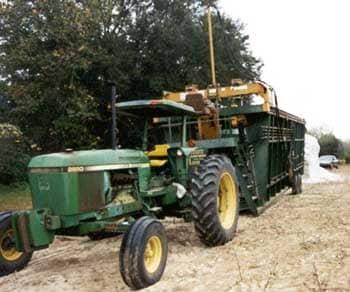
|
|
Cotton Packing Machine Used in this Incident
|
Introduction
On November 22, 1999, a 16-year-old male farm worker (the victim) died in a cotton packing machine after a load of cotton was dumped on top of him, causing compression asphyxiation and suffocation. On November 30, 1999, officials of the Wage and Hour Division of the Department of Labor notified the Division of Safety Research (DSR) of this fatality. On December 13, 1999, two DSR occupational safety and health specialists conducted an investigation of the incident. The incident was reviewed with personnel from county sheriff and medical examiner’s offices. The employer was interviewed and accompanied investigators to fields where the cotton packing machine and the cotton picker used on the day of the incident were stored. Photographs were obtained and measurements taken during the course of the investigation.
The employer, who had operated the cotton farm for approximately 35 years, employed the victim and one other worker. He provided on-the-job training which included training in the operation of all of the machines used on the cotton farm. The employer did not have a written safety plan. The victim was no longer attending school and was working for the farm owner on a part-time basis as he had for approximately 6 years. This was the first fatality experienced by the employer.
Back to Top
Investigation
At 5 p.m. on the day of the incident, the victim joined the farm owner and a co-worker who had been harvesting cotton since approximately 8 a.m. that morning. The victim worked packing and picking cotton for several hours and at approximately 9:30 p.m., he rode with a co-worker on the picker until the basket on the picker was nearly full of cotton (Figure 1). The picker operator stopped and told the victim to walk over to the cotton packing machine and get ready to pack the next load of cotton, while he finished picking. The victim’s task would have entailed starting the tractor used to power the cotton packing machine and, using hand controls to operate a hydraulically actuated tamper, compress the cotton. According to the farm owner there was no work-related reason for the victim to enter the box of the cotton packing machine. The farm owner was working in the same cotton field, cutting stalks with a bush hog after the picker had harvested the cotton. The picker operator resumed picking and approximately 30 minutes later, he drove the 240-horsepower picker alongside the cotton packing machine, with a full load. He noticed that the tractor used to power the power take-off driven packer was shut off and that the lights on the cotton packing machine were not illuminated (Figure 2).
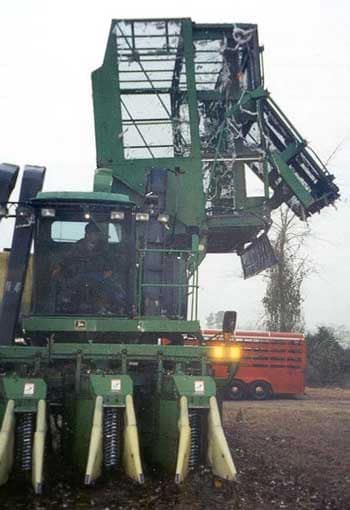
|
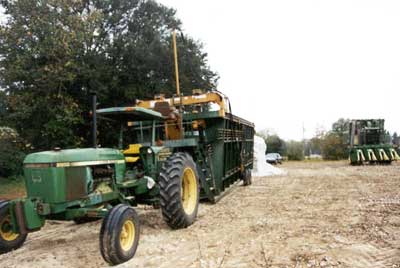
|
|
Figure 2. Cotton Packing Machine Used in This Incident
|
The picker operator did not see the victim and, thinking he had walked to his truck to get some tobacco, dumped half of his load of cotton into the rear of the box and the other half into the front of the box. After he dumped the load, which weighed approximately 3500 pounds, he got down from the picker and called to the victim, telling him to get back to the machine to pack the cotton. Several loads of cotton had been packed and this was the last load needed to complete the stack. The plan was to quit for the night immediately after the load was packed. The farm owner had returned to the packing area after cutting stalks, and both men became concerned when the victim did not return. They checked his truck and the surrounding area and, when they could not locate him, decided to pull the cotton packing machine forward with the tractor in order to expose the stack of cotton inside. They found the victim buried within the stack in loose cotton (Figure 3) approximately 6 feet from the front end of the packer (the end closer to the control station), and pulled him out. Approximately 30 minutes had elapsed since the cotton had been dumped. When they assessed the victim, they could not find a pulse and the victim was not conscious or breathing. The farm owner ran to a work truck parked nearby at approximately 10:30 p.m. and used a mobile phone to call 911 while the co-worker initiated cardiopulmonary resuscitation (CPR). Law enforcement officers arrived within 10 minutes and took over CPR efforts. EMS arrived within approximately 20 minutes of the 911 call and transported the victim to a local hospital where he was pronounced dead, approximately 2 hours after the incident.
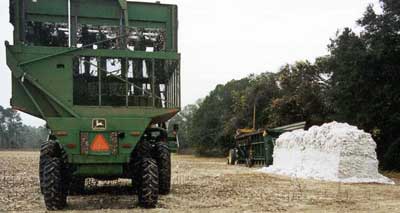
|
|
Figure 3. Cotton Stack in which Victim was Found
|
The cotton packing machine in which the victim died was called a super packer module builder (Figure 2). It was approximately 10 years old and was power take-off (PTO) driven. The machine was used to pack cotton into a cotton stack (module) which measured 32 feet long by 10 feet-4 inches wide by 10 feet high when completed. The machine used in the incident required an operator to sit at a control station located 12 feet from the ground, facing the box into which cotton was dumped (Figure 4). The operator controlled a hydraulically actuated tamper which compressed the cotton against the ground (Figure 5). The tamper was mounted on a chain-driven bridge spanning the sides of the packer box. When packing cotton, the operator alternately tamped the cotton, repositioned the bridge and then tamped again, continuing the process after each load was dumped until a compacted stack of cotton was formed and was ready for transport. The operator had complete control of the packing operation from the operator station. According to the owner, the cotton packing machine was operating without problems on the day of the incident.
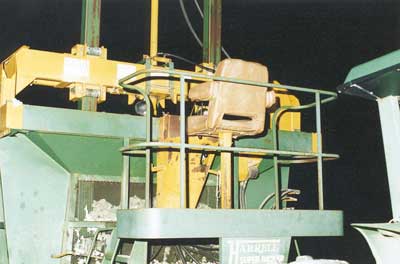
|
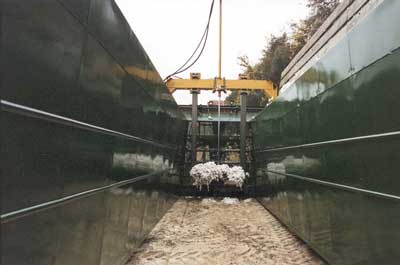
|
|
Figure 5. Hydraulically Actuated Tamper Used to Compress Cotton Against the Ground
|
Back to Top
Cause of Death
The Medical Examiner listed the cause of death as compression asphyxia and suffocation.
Recommendations and Discussion
Recommendation #1: Employers should develop, implement, and enforce a policy that prohibits workers from entering the box of cotton packing machines and that requires a visual inspection of the box and the use of an agreed-upon signaling system prior to dumping cotton into the box.
Discussion: Workers should be prohibited from entering the box of cotton packing machines. In order to make certain that no one is inside the box when cotton is dumped, the packing machine operator should illuminate the area and perform a visual inspection of the inside of the box from the operator station, prior to each dump. After determining that no one is inside the box, the packing machine operator should use an agreed-upon signal to direct the picker operator to dump the load of cotton.
Normal work procedures do not require workers to enter the box. If mechanical problems occur that require a worker to enter the box, safety procedures that follow lockout and tag out provisions should be followed, along with the use of the agreed-upon signaling system as described earlier, prior to resumption of work.
According to the employer and the law enforcement authorities interviewed, workers commonly sleep on the cotton stack inside the box of cotton packing machines when they have free time between cotton harvesting operations. In order to change this unsafe behavior, employers should develop, implement and rigidly enforce a policy that prohibits workers from entering the box. Additionally, the policy should specify safe locations for lunch and rest breaks located away from the cotton stack and from other farm operations that may pose a safety risk.
Recommendation #2: Employers should develop, implement, and enforce a comprehensive safety program for all employees which includes, but is not limited to, training in hazard identification, avoidance, and abatement.
Discussion: Research has shown that those working in farming occupations are at increased risk for serious injury and death in the workplace. Training in recognizing and avoiding hazards should be given to all workers but is especially important in view of the size and power of the machines used and the long work shifts on farms, which frequently extend into the night.
Because youth age 16 years and older are currently allowed by Federal Child Labor Laws to work any hours on farms and are allowed to operate all types of farm machinery,1 employers should make frequent assessments to determine if their youthful workers are competent in the recognition of hazards and safe work practices and should provide additional training when needed.
Reference
DOL (1990b). Child labor requirements in agricultural occupations under the Fair Labor Standards Act. Washington D.C.: U.S. Department of Labor, Employment Standards Administration, Wage and Hour Division WH 1295.
Back to Top
Investigator Information
This investigation was conducted by Doloris N. Higgins and Greg J. Smith, Occupational Safety and Health Specialists, Fatality Assessment and Control Evaluation Team, Surveillance and Field Investigations Branch, Division of Safety Research.
